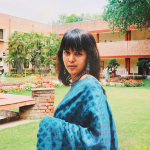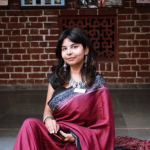by Aarushi Anand and Parthika Sharma
Content Warning: The following article contains sensitive content related to the Partition and engages with topics of violence, sexual assault, trauma, suicide, and death. The content may trigger emotional distress. Reader discretion is advised.
I am also of humankind
I am the sign of that injury,
The symbol of that accident,
Which, in the clash of changing times,
Inevitably hit my mother’s forehead
.
.
.
Who can guess
How difficult it is
To nurse barbarity in one’s belly
To consume the body and burn the bones?
I am the fruit of that season
When the berries of Independence came into blossom.
– Amrita Pritam[1]
At the stroke of midnight on 15th August 1947, as the world slept, India awoke to life and freedom. However, this freedom came with huge losses- loss of land, loss of ties, loss of hope and loss of humanity. The political and social developments of the past years led to Partition of British India into two nations- India and Pakistan. The era of Partition was tumultuous, it seemed like no one was sure where India ended and Pakistan started, no one was sure how their citizenship would be determined and that led to a burst of unprecedented violence. Hindus, Muslims and Sikhs turned upon one another and left 15 million displaced and 1 million dead.
As family, community, and national identities were redefined, one group was affected differently and arguably more violently than others- the othered women. Scholars including Ritu Menon, Kamla Bhasin, Urvashi Butalia, Paola Buchetta and Veena Das have looked at Partition through a gendered lens to explore how women’s bodies were treated as something that can be possessed and violated to dishonor the “other” community. “Othered” women were subject to stripping; parading naked; mutilating and disfiguring; tattooing or branding the breasts and genitalia with triumphant slogans; amputating breasts; knifing open the womb; raping and killing foetuses.[2]
How were women supposed to react to their situation? Was there a ‘right reaction’? The Indian and Pakistani Governments at that time and Nationalists from both countries certainly thought so and prescribed the feeling of loss, disgust, betrayal and longing for home to women without taking what they wanted into account.[3] States were determined to “rescue” their “sisters” without taking into account the women’s wishes and agency. Even women who protested were forcibly brought back to their natal families.
Photo by Jan Canty via Unsplash
However, when Partition is viewed through the trope of ‘the citizen’ and individual accounts are analyzed, it is clear that the experience of Partition was varied. These experiences were expressed in literary and dramatic narratives. Looking at narratives portrayed in various accounts via the prism of gender illuminates the bending of gendered experience into many different shades. Through the use of three fictional works, we seek to analyze the varied unorthodox experience of Partition.
Sadat Hassan Manto, a Pakistani writer, evokes the sight of life as it passes him by. In his novel Thanda Gosht (Cold Meat) when Ishar Singh fails to be aroused by his spouse Kulwant she suspects infidelity and stabs him with his dagger. In his last moments, Ishar confesses how he wrecked a Muslim family during the riots and abducts a girl, with the intention of raping her. However, upon penetrating the girl, he discovers that she is dead. The reader is left to assume that he in fact raped her cold flesh. Thanda Gosht transfers the victim’s shame onto the offender. The rape had rendered Ishar impotent, undermining the notion of rape as a display of masculine power.
By reducing Ishar Singh to nothing more than a lifeless piece of flesh, the writer creates an analogy between the lifelessness of the protagonist and the lifelessness of the corpse he attempted to rape. Kalwant’s reaction demonstrates the disintegration of a patriarchal social system as a woman asserts and exercises her sexual agency, seizing control from her husband on account of adultery. One can argue that Kulwant’s reaction was in many ways due to the violence around her, which would have allowed her violence to be overseen and that she would not have stabbed him in normal circumstances. The Partition led to a breakdown of social relations which created a space for her to express her feelings and take a stance for herself rather than ignoring the suspected adultery of her husband. While conservatives associate feminine wrath with gendered madness, Manto’s use of female rage in a gender biased climate reaffirms women’s defiance against male authority. Kalwant’s feelings are channelized by means of her rage, and underneath this anger lay a plethora of questions challenging all the chains of patriarchy which were placed around her.
Many women accepted their new situation, even finding happiness and love with their ‘abductors’. Indian Novelist Amrita Pritam’s novel Pinjar narrates the story of a young Hindu woman named Pooro who is kidnapped by a Muslim man Rashid during the 1947 riots to avenge an age-old land dispute between their family. Pooro’s sexual assault by Rashid is accompanied by her family’s rejection of her and the following societal ostracism. The only tool for women to survive their loss of “purity” was to reconcile with their converted identity. The story recounts Pooro-turned-Hamida’s gradual journey of acceptance, culminating in “love” for her captor. Rashid’s assistance in locating a missing Hindu woman during the riots was an essential factor in her metamorphosis. Touched by his act of redemption Pooro chose to continue with her new life despite having been offered the hand of her ex-fiance Ramchand.
Pinjar explores the challenges faced by women during the Partition without vilifying or honoring any side. This was critical in 1950 when India’s widespread political rhetoric defined female bodies by presenting all abducted women as legendary Sitas, the mythical Hindu Goddess who was kidnapped but managed to stay pure. At the peak of communal polarization the invocation of the Hindu goddess surreptitiously framed all captured women as Hindu, seeking security against Muslim abductors who were framed as the demon Ravana, the kidnapper of Sita. Such discourses on protectionist ideology aimed to reinstate Hindu patriarchal control over female sexuality and at the same time demonising the Muslim community. In the madness of dominant Hindutva ideologies threads of gendered and communitarian bigotry got enmeshed to intensify the already prevalent violence and disruption. Loss of life and livelihood boosted antagonism between Hindus and Muslim, and made the very people who were “one” into enemies. The violent history of both sides though have a touch of redeeming aesthetic: a sign of reclamation and oneness in recognising resilient moments in the understanding of human misery, which in turn ignites empathy for the persecuted.[4]
Kirti Jain’s 2001 play, Aur Kitne Tukde, dramatizes the journey of four female bodies as they dared to tread the path of men belonging to opposing communities. Harnam Kaur, one of the characters, is based on Urvashi Butalia’s oral narrative of a Thoa Khalsa survivor. In Thoa Kalsa, more than ninety Sikh women committed mass suicide by diving into a well in March 1947 in order to avert sexual misconduct.
According to Kriti Jain, Harnam Kaur was actually relieved that her effort had failed and she was still alive. The story challenges popular conceptions of martyrdom, which hold that all women choose to become martyrs by acting in accordance with their “own free will.” The women who committed mass suicide had to make the terrible choice between torture, ignominy, ostracism, and death. In attempting to kill herself, then, Jain suggests, Harnam Kaur was surrendering to community and masculinist pressure and subduing her own will to live. Jain emphasizes how critical it is to pay attention to these subtle resistance signals that subvert hegemonic narratives surrounding the gendered martyr. Despite Harnam Kaur’s weak protests, her voice was quickly appropriated into wider masculinist tales of martyrdom and sacrifice, even though she had no desire to die.
Partition was one of the darkest periods in the Indian subcontinent’s history, however, it cannot be measured in terms of black and white. It was grayer for some, albeit black for most. It is vital to pull out individual orthodox experiences enmeshed in broader and generalised narrations of Partition. Through the fictional pieces discussed above reality was taken to its extreme levels, enabling us to see how Partition meant something else for every person. In Thanda Gosht, two women symbolically subject Ishar Singh to physical, psychological, emotional, and sexual trauma as a parallel to everything women were subjected to in the war between the religions. On the other hand, Pinjar shows how women came in terms with their new found identities and even made good lives for themselves through love. Aur Kitne Tukde points to how women’s voices were subdued by patriarchal notions, but they still found space. There are various other narratives apart from the three mentioned above which show the unusual experience of Partition, and it is important to recognise these differences. A scrapbook of experiences, a mess of blurry and distinct images, is the only true picture of Partition.
 Aarushi Anand is a graduate in History honours from Miranda House, University of Delhi. She is currently pursuing LLB from Faculty of Law, University of Delhi. Her passion for storytelling fuels her writings, which majorly focus on history, gender, legal and social issues. Aside from her academic pursuits, Aarushi enjoys spending her free time sketching the world around her.
Aarushi Anand is a graduate in History honours from Miranda House, University of Delhi. She is currently pursuing LLB from Faculty of Law, University of Delhi. Her passion for storytelling fuels her writings, which majorly focus on history, gender, legal and social issues. Aside from her academic pursuits, Aarushi enjoys spending her free time sketching the world around her.
 Parthika Sharma is a graduate in History honours from Miranda House, University of Delhi. Her interest lies in Mughal History, Art Restoration and Linguistics. In addition to her academic pursuits, Parthika enjoys spending her free time painting, clicking photographs, and engaging in impromptu choreography.
Parthika Sharma is a graduate in History honours from Miranda House, University of Delhi. Her interest lies in Mughal History, Art Restoration and Linguistics. In addition to her academic pursuits, Parthika enjoys spending her free time painting, clicking photographs, and engaging in impromptu choreography.
References
Mehta, Rini Bhattacharya, and Debali Mookerjea-Leonard, eds. The Indian Partition in literature and films: History, politics, and aesthetics. Routledge, 2014.
Malhotra, Aanchal. Remnants of a separation: A history of the Partition through material memory. New Delhi, India: HarperCollins India, 2017.
Bhalla, Alok. “The Politics of Translation: Manto’s Partition Stories and Khalid Hasan’s English Version.” Social Scientist (2001): 19-38.
Jalal, Ayesha. The pity of Partition: Manto’s life, times, and work across the India-Pakistan divide. Princeton University Press, 2013.
Kaul, Suvir. “Remembering Partition: Violence, nationalism and history in India.” Journal of Colonialism and Colonial History 3, no. 3 (2002).
Daiya, Kavita. Violent belongings: Partition, gender, and national culture in postcolonial India. Temple University Press, 2011.
Menon, Ritu, and Kamla Bhasin. Borders & boundaries: women in India’s Partition. Rutgers University Press, 1998.
Butalia, Urvashi. “Community, state and gender: On women’s agency during Partition.” Economic and political weekly (1993): WS12-WS24.
Menon, Ritu, and Kamla Bhasin. “Recovery, rupture, resistance: Indian state and abduction of women during Partition.” Economic and political weekly (1993): WS2-WS11.
Bacchetta, Paola. “Reinterrogating Partition violence: Voices of women/children/Dalits in India’s Partition.” (2000): 567-585.
[1]Singh, Attar. “Modernity and Contemporary Punjabi Poetry.” Indian Literature 11.3 (1968)
[2] Ritu Menon and Kamla Bhasin, Borders & boundaries: women in India’s Partition, Rutgers University Press, 1998, p.43
[3] Butalia, Urvashi. “Community, state and gender: On women’s agency during Partition.” Economic and political weekly (1993): WS12-WS24.
[4] Rumi, Raza, Reclaiming Humanity: Women in Manto’s Short Stories, Social Scientist 40, no. 11/12 (2012), p. 85


